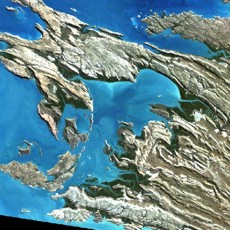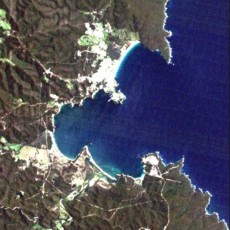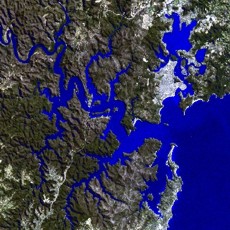Also known as: drowned river valleys, oceanic embayments, rias, fjords.
Conceptual model diagrams of embayments and drowned river valleys
 Physical Characteristics
Physical Characteristics
Sedimentary Environments (Habitats)
Hydrology
Sediment Transport
Nitrogen Dynamics
Key features of embayments
- Habitats are typically marine, with extensive subtidal environments and very narrow intertidal environments.
- Large entrance and efficient marine flushing, even in microtidal regions. Deep water.
- River flow varies, floods are buffered and do not expel marine water due to large water area.
- Turbidity and extent of intertidal habitats are dependant on local tidal range.
- Sediment (and associated contaminants) are generally not trapped. Typically floored by coarse sediment.
- Nutrient dynamics are generally similar to the coastal ocean.
- ‘Immature’ in terms of evolution: morphology may slowly change over time due to infilling.
Geomorphology
Embayments are the least geomorphologically complex of the seven coastal waterway classes, as they typically comprise a bedrock-lined coastal indentation (Hudson, 1991). In Australia, embayments occur along hard coasts (see Classification map), where they appear as topographic depressions or indentations in the country rock, that have not been significantly infilled by terrigenous or marine sediment (see Examples below).
The morphology of embayments may comprise wide and rounded bays, highly indented bays with convolute shorelines, or narrow and tapered drowned river valley systems (Albani et al., 1974, Albani et al., 1975, Perillo, 1995, Morrisey, 1995, Riggs et al., 1995). Embayments are generally bound by steep, rocky shorelines, have relatively wide, unconstricted entrances with free exchange to the ocean, and are deep relative to other coastal waterway types (Roy et al., 1980, Roy et al., 1981). The submarine topography is smooth, and typically slopes gently toward the mouth (Abell et al., 1993). River inputs (although sometimes large during peak flow conditions) are, in the long-term, small relative to the total water volume contained with the embayment and exchanged with the ocean (Hudson, 1991, Roy et al., 2001). The relative influence of waves and tides in embayments is variable, and depends on regional conditions.
In Australia, embayments are equally abundant on both wave- and tide-dominated coasts. Variations in orientation, configuration, and water depth affects the penetration of waves; strongly indented embayments support more sheltered environments, and tidal processes tend to dominate upstream (Roy et al., 1980). Due to friction, wave and tide influence are generally reduced with distance from the entrance of the embayment. Localised bedrock features such as headlands or offshore islands may also form a protective barrier and limit wave penetration into embayments. Due to a typically large exchange of water during the tidal cycle (or tidal prism), embayments are usually considered to be tide-dominated, even on microtidal coasts (Andersson et al., 1986, Roy et al., 2001, Cooper, 2001).



Figure 1.: Examples of oceanic embayments: Cascade Bay (WA) – indented, Twofold Bay (NSW) – rounded, and Broken Bay (NSW) – narrow drowned river valley.
Evolution
Generally, embayments are the evolutionary precursors of modern wave-and tide-dominated estuaries and deltas (Roy et al., 2001, Fitzgerald et al., 2000). The rate of infilling by sediment depends on sediment supply from the catchment and marine sources, and the original volume of the basin. Thus, the present-day distribution of embayments is restricted to areas of complex, rocky coastal morphology, and low sediment supply. Given sufficient time, continuous sediment supply, and stable sea level, embayments ultimately ‘fill in’, and have the potential to become wave- or tide-dominated estuaries, and subsequently wave- or tide-dominated deltas (Heap et al., 2001).
Habitats and ecology
Embayments represent transitional environments between true estuarine and marine environmental conditions (such as salinity, water temperature, turbidity, and energy) and thus contain an abundant and highly variable biota (Dethier, 1992, Rainer et al., 1981b Roy et al., 2001). Depending upon energy conditions and climate (latitude), habitats such as saltmarshes, mangroves, intertidal flats, and sandy beach environments fringe the embayment. Swamp areas and freshwater wetlands tend to occur behind prograding sandbars (Abell et al., 1993). Clear shallow waters support various seagrasses (Abal et al., 1996, Humphries et al., 1992), rocky shores, and rocky (or coral) reefs.


